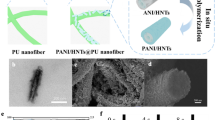Abstract
Silver nanoparticles (AgNPs), synthesized using N,N-dimethylformamide (DMF), were electrospun with nisin in a 50:50 blend of 24 % (w/v) poly(d,l-lactide) (PDLLA) and poly(ethylene oxide) (PEO). Addition of AgNPs decreased the average diameter of the nanofibers [silver nanofibers (SF)] from 588 ± 191 to 281 ± 64 nm, or to 288 ± 63 nm when nisin was co-spun with AgNPs. Nanofibers containing AgNO3 (SF) had a beads-on-string structure, whereas nanofibers with AgNPs and nisin [silver plus nisin nanofibers (SNF)], nanofibers with only nisin [nisin nanofibers (NF)], and nanofibers without AgNPs and nisin [control nanofibers] had a uniform structure. The irregular topography was confirmed by atomic force microscopy. No interactions occurred between silver, nisin, PDLLA, and PEO, as confirmed with Fourier transform infrared spectroscopy. Most of the AgNPs (18 ± 2.8 ppm) and nisin (78.1 ± 1.2 µg/ml) were released within the first 2 h. SF and SNF inhibited the growth of gram-positive and gram-negative bacteria, whereas NF failed to inhibit gram-negative bacteria. A wound dressing with broad-spectrum antimicrobial activity may be developed by the incorporation of nanofibers containing a combination of AgNPs and nisin.




Similar content being viewed by others
References
Ahire JJ, Dicks LMT (2014) Nisin incorporated with 2,3-dihydroxybenzoic acid in nanofibers inhibits biofilm formation by a methicillin-resistant strain of Staphylococcus aureus. Probiotics Antimicrob Proteins 7:52–59
Ahire JJ, Neppalli R, Heunis TD, van Reenen AJ, Dicks LMT (2014) 2, 3-dihydroxybenzoic acid electrospun into poly(d,l-lactide) (PDLLA)/poly (ethylene oxide) (PEO) nanofibers inhibited the growth of gram-positive and gram-negative bacteria. Curr Microbiol 69(5):587–593
Ahire JJ, Dicks LMT (2014) 2,3-Dihydroxybenzoic acid-containing nanofiber wound dressings inhibits biofilm formation by Pseudomonas aeruginosa. Antimicrob Agents Chemother 58(4):2098–2104
Borase HP, Salunke BK, Salunkhe RB, Patil CD, Hallsworth JE, Kim BS, Patil SV (2014) Plant extract: a promising biomatrix for ecofriendly, controlled synthesis of silver nanoparticles. Appl Biochem Biotechnol 173:1–29
Carmona-Ribeiro AM, de Melo Carrasco LD (2014) Novel formulations for antimicrobial peptides. Int J Mol Sci 15(10):18040–18083
Chernousova S, Epple M (2013) Silver as antibacterial agent: ion, nanoparticle, and metal. Angew Chem Int Ed 52:1636–1653
Chopra I (2007) The increasing use of silver-based products as antimicrobial agents: a useful development or a cause for concern? J Antimicrob Chemother 59(4):587–590
Dolina J, Jiříček T, Lederer T (2013) Membrane modification with nanofiber structures containing silver. Ind Eng Chem Res 52(39):13971–13978
Fouda MM, El-Aassar MR, Al-Deyab SS (2013) Antimicrobial activity of carboxymethyl chitosan/polyethylene oxide nanofibers embedded silver nanoparticles. Carbohydr Polym 92(2):1012–1017
Heunis TDJ, Smith C, Dicks LMT (2013) Evaluation of a nisin-eluting nanofiber scaffold to treat Staphylococcus aureus-induced skin infections in mice. Antimicrob Agents Chemother 57:3928–3935
Heunis TDJ, Dicks LMT (2010) Nanofibers offer alternative ways to the treatment of skin infections. J Biomed Biotechnol 61:1–10
Kopermsub P, Mayen V, Warin C (2012) Nanoencapsulation of nisin and ethylenediamine tetra acetic acid in niosomes and their antimicrobial activity. J Sci Res 4:457–465
Leive L (1965) Release of lipopolysaccharide by EDTA treatment of E. coli. Biochem Biophys Res Commun 21:290–296
Noginov MA, Zhu G, Bahoura M, Adegoke J, Small C, Ritzo BA, Shalaev VM (2007) The effect of gain and absorption on surface plasmons in metal nanoparticles. Appl Phys B 86(3):455–460
Pastoriza-Santos I, Liz-Marzán LM (1999) Formation and stabilization of silver nanoparticles through reduction by N,N-dimethylformamide. Langmuir 15(4):948–951
Randall CP, Oyama LB, Bostock JM, Chopra I, O’Neill AJ (2013) The silver cation (Ag+): anti staphylococcal activity, mode of action and resistance studies. J Antimicrob Chemother 68(1):131–138
Schved F, Henis Y, Juven BJ (1994) Response of spheroplasts and chelator-permeabilized cells of gram-negative bacteria to the action of the bacteriocins pediocin SJ-1 and nisin. Int J Food Microbiol 21:305–314
Sichani GN, Morshed M, Amirnasr M, Abedi D (2010) In situ preparation, electrospinning, and characterization of polyacrylonitrile nanofibers containing silver nanoparticles. J Appl Polym Sci 116(2):1021–1029
Singh AP, Prabha V, Rishi P (2013) Value addition in the efficacy of conventional antibiotics by Nisin against Salmonella. PLoS One 8(10):e76844
Wang Y, Yang Q, Shan G, Wang C, Du J, Wang S, Wei Y (2005) Preparation of silver nanoparticles dispersed in polyacrylonitrile nanofiber film spun by electrospinning. Mater Lett 59(24):3046–3049
Wu J, Zheng Y, Song W, Luan J, Wen X, Wu Z, Guo S (2014) In situ synthesis of silver-nanoparticles/bacterial cellulose composites for slow-released antimicrobial wound dressing. Carbohydr Polym 102:762–771
Zacharof MP, Lovitt RW (2012) Bacteriocins produced by lactic acid bacteria a review article. APCBEE Procedia 2:50–56
Acknowledgments
Ahire JJ is grateful to the Claude Leon Foundation, Cape Town, South Africa, for a postdoctoral fellowship.
Author information
Authors and Affiliations
Corresponding author
Electronic supplementary material
Below is the link to the electronic supplementary material.
284_2015_813_MOESM1_ESM.pptx
Supplementary material 1 Energy-dispersive X-ray (EDX) analysis of (a) silver nanofibers (SF) and silver plus nisin nanofibers (SNF). C: carbon, O: oxygen and Ag: silver (PPTX 97 kb)
284_2015_813_MOESM2_ESM.pptx
Supplementary material 2 Atomic force microscopy (AFM) images of (a) control nanofibers (CF), (b) silver nanofibers (SF), (c) nisin nanofibers (NF), and silver plus nisin nanofibers (SNF) (PPTX 303 kb)
Rights and permissions
About this article
Cite this article
Ahire, J.J., Neveling, D.P. & Dicks, L.M.T. Co-spinning of Silver Nanoparticles with Nisin Increases the Antimicrobial Spectrum of PDLLA: PEO Nanofibers. Curr Microbiol 71, 24–30 (2015). https://doi.org/10.1007/s00284-015-0813-y
Received:
Accepted:
Published:
Issue Date:
DOI: https://doi.org/10.1007/s00284-015-0813-y




